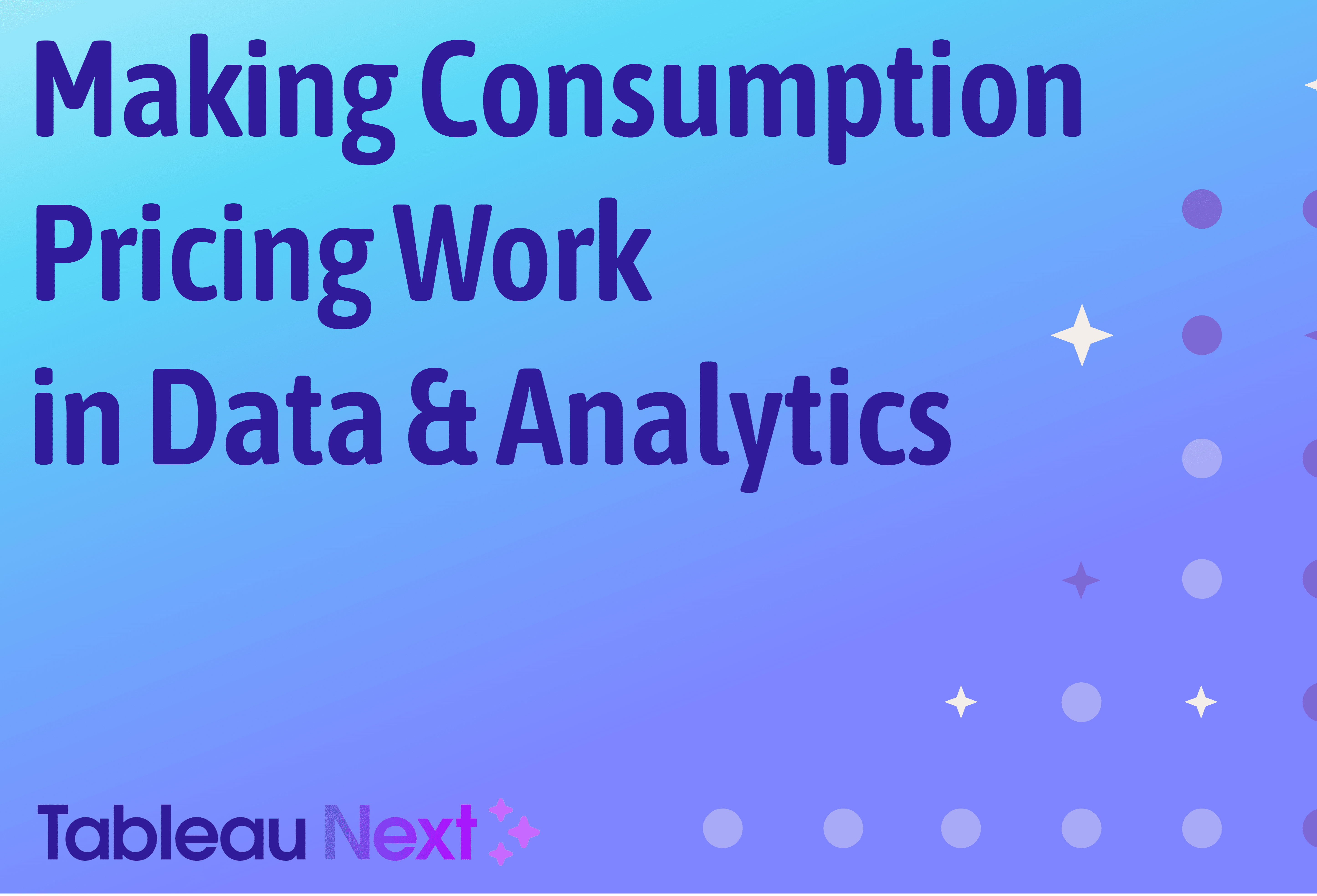
How Does Tableau Next Pricing Work?
First, let’s get the mechanics out of the way. Tableau Next is packaged as part of the Tableau Plus bundle, meaning you still get everything you’d expect from Tableau Cloud: Advanced Management, Data Management, Tableau Pulse Premium Features, etc. Tableau Next itself is embedded into a Salesforce environment, either an existing one or a new instance if you're not a Salesforce user, and follows a consumption-based pricing model.
You still have your familiar Creators, Explorers, and Viewers for Tableau Classic, and you'll get a corresponding number of users in the Tableau Next environment. But then things shift.
Consumption charges are based on three key elements:
1. Data Cloud Usage
Every dashboard you build in Tableau Next creates queries against Data Cloud. The number of visuals, filters, dimensions, and users all factor into the query load. So, the more complex the dashboard, the higher the potential cost.
2. Einstein Credits
These are used for automated metric summaries (like Tableau Pulse metrics) and other AI-powered features like Data Pro.
3. Flex Credits
These come into play when users ask natural language questions (via the Concierge skill in AgentForce) essentially tapping into LLM-powered querying of data.
You’ll get a base amount of these credits with your Tableau Next licence and pay for additional usage as needed. These models have been around in Analytics for Cloud Warehousing, but still on paper, this sounds like a lot, and in talking to customers I've found it does require a mindset shift.
Why This Feels So Different
With Tableau Classic, BI teams could publish dashboards freely, that lends a lot of power, allowing users to quickly share insights and get answers fast. However, there wasn't a financial incentive to optimise, reduce noise, or retire old content. Dashboards became a background hum: always running, not always helping.
So that model created problems. Dashboards are often: released without a clear value case, rarely measured on impact, often unused or misunderstood, a drain on server resources and end-user clarity.
And as a result, many BI teams became dashboard factories. Churning out deliverables without always knowing whether they were moving the needle. It made answering questions like “What’s the business value of your work?” surprisingly hard. As a result BI is increasingly seen as a cost as opposed to profit centre in some organisations.
It's not that the Tableau Classic pricing model doesn't work, it just needs management, like anything, and that takes effort and thought to work through.
The Real Opportunity of Consumption Pricing
Tableau Next flips that on its head.
Now, before you publish a dashboard, you’re incentivised to ask: What’s the expected value of this dashboard? Who will use it, and how often? Is the insight worth the cost to deliver and run it?
It introduces a product-thinking mindset. Each dashboard becomes something you need to invest in, not just something you build and hope people use. And with usage tied to cost, it becomes easier to stop low-value projects at the POC stage. That’s something BI teams have traditionally struggled with.
This isn’t just a pricing model shift, it’s a cultural one.
Challenges Ahead (Positive Ones)
Let’s not sugar-coat it: this model creates challenges.
Customers will need to understand, forecast, and plan for cost in a way they’ve never had to.
Consultants will have to focus on performance tuning, design efficiency, and cost-justification from the start.
Salesforce reps will need to clearly communicate these trade-offs during sales and onboarding, and make sure customers aren’t caught off guard.
But this is where I think partners like The Information Lab can shine. Our job isn’t just to help build dashboards, it’s to help teams understand the cost/benefit landscape, design with intent and align delivery with their business goals.
This model forces us all, vendors, partners, and customers, to focus on what matters: delivering valuable, used, and impactful analytics.

The Camera Analogy
This analogy was something we talked about a lot 12 years ago; Tableau, like digital cameras, offered a meaningful change. They allowed people to avoid the expensive costs of film cameras and all the development costs, and instead simply have images at the click of a button. Tableau offered the same, insight minutes away.
I now can create snapshots to share on my phone and get loads of short term value out of those photos too. And they are great to look back on occasionally. They capture unexpected moments and insights I'd never capture if I planned them - those are priceless. However, I also have tens of thousands of photos on my phones I don't look back on, and like a mug I'm paying for Google One to store them as I don't have time to work out what I want to keep.
But...that photo on my lounge on the wall of the whole family? I want real value from that. So I'll pay good money. Getting all the family together from other ends of the country, buying new clothes, that all takes time and money but it's worth it because you have value in mind. This is something you'll look at every day. So you pay the cost and it's worth it. No one goes to a photographer without having a clear idea what they want to do with the photo.
And so it is with Tableau Next, you're creating a digital product that your sales or service team will use day in day out, it'll drive real value and so you're happy to pay consumption costs to drive that. Unlike a photograph though, if you don't get the usage in the initial period, you stop looking at it, your costs go down and you can turn it off.
Tableau Plus provides Flexibility and Choice
The great thing is that you're not being forced to choose with Tableau Plus, you will keep your Tableau Classic licences and your users can use them to drive insights to users at the speed you need to make decisions, like they always have. Now though, you also get Tableau Next to help build dashboards, within Salesforce, that can help drive real, deliberate value and change right where people work.
The decision about where to build and which use cases are suited to which environment will be nuanced, but partners like The Information Lab can help guide your thinking in how to build the best Tableau Classic and Tableau Next environments, and get drive real value from both.
A Final Thought
Yes, consumption pricing requires a shift in thinking. But it’s a welcome one.
It pushes BI teams to move from “deliverables” to outcomes. From dashboard factories to value creators. And in a world increasingly focused on ROI, that’s exactly where we need to be.
